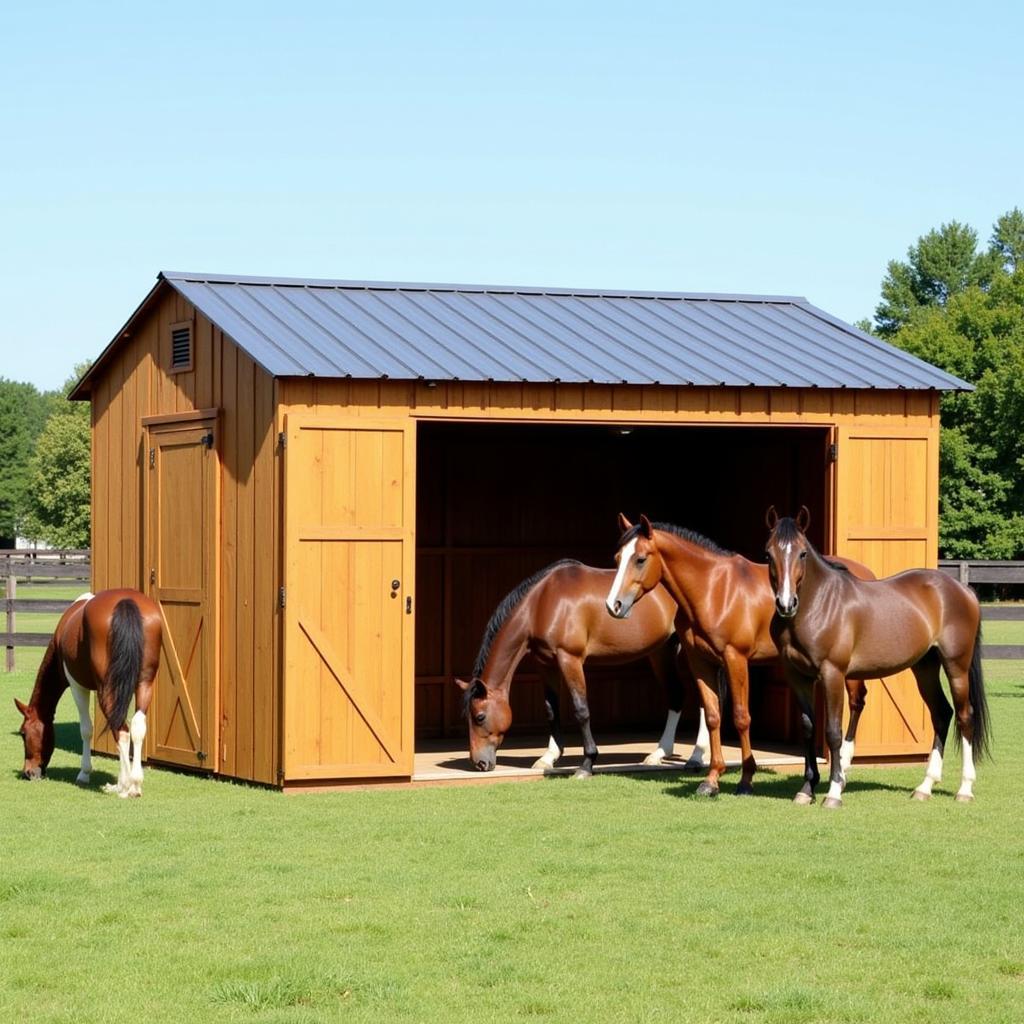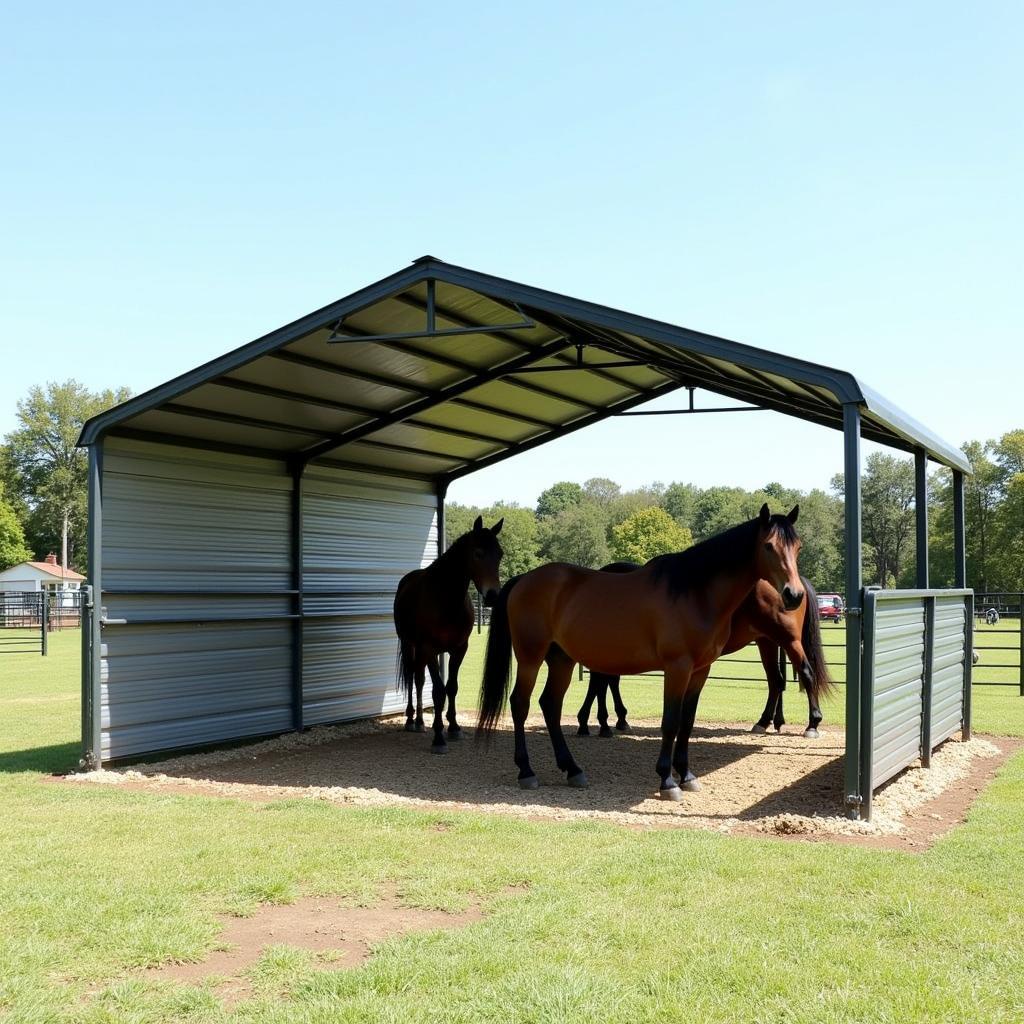Providing adequate shelter is crucial for the well-being of your horses. Horse Paddock Shelters offer protection from the elements, ensuring your horses stay healthy and comfortable year-round. Whether you have a small hobby farm or a large equestrian facility, selecting the right shelter is a vital investment. This article will guide you through everything you need to know about horse paddock shelters, helping you make an informed decision.
Choosing the right shelter involves considering various factors, from the size and material to the placement and additional features. A well-chosen shelter can significantly enhance the quality of life for your horses, offering respite from sun, wind, rain, and snow. Finding the perfect shelter doesn’t have to be a daunting task. Let’s dive into the key aspects of selecting the perfect horse paddock shelters. Learn how you can ensure your horses have a comfortable and safe environment in their paddocks. After learning about horse shelters, you might want to also consider a 5′ horse fence for added security and containment.
Types of Horse Paddock Shelters
Several types of horse paddock shelters cater to different needs and budgets. Understanding these variations will help you determine the most suitable option for your horses and property.
Run-in Sheds
Run-in sheds are the most common type of horse shelter. They are three-sided structures that offer basic protection from the elements. Their open design allows horses to freely enter and exit as needed.
Portable Shelters
Portable shelters offer flexibility and can be moved around the paddock as required. This can be particularly useful for rotational grazing systems.
Shed Rows
Shed rows provide individual stalls within a larger structure. This is a good option for horses requiring individual space or specialized care.
Barn Stalls with Paddock Access
Barn stalls with paddock access offer a combination of indoor and outdoor space. Horses can enjoy the comfort of a stall while still having access to a paddock.
 Run-in Shed Horse Paddock Shelter Example
Run-in Shed Horse Paddock Shelter Example
Factors to Consider When Choosing Horse Paddock Shelters
Selecting the appropriate horse paddock shelter depends on several crucial factors. Careful consideration of these elements ensures the shelter effectively serves its purpose.
Size and Capacity
The size of the shelter should be appropriate for the number of horses using it. Overcrowding can lead to discomfort and potential injuries. A good rule of thumb is to provide at least 100 square feet per horse.
Material and Durability
Shelters are typically constructed from wood, metal, or a combination of both. Consider the climate and potential exposure to harsh weather when choosing the material.
Location and Placement
The shelter should be strategically placed within the paddock to maximize its effectiveness. Consider prevailing winds, sun exposure, and drainage when selecting the location. You might also be interested in creating a fun and stimulating environment for your horses. Take a look at this article about horse playground for some great ideas.
Ventilation and Airflow
Proper ventilation is essential to prevent the buildup of moisture and ammonia. Ensure the shelter has adequate airflow to maintain a healthy environment.
Maintaining Your Horse Paddock Shelters
Regular maintenance is essential to prolong the life of your horse paddock shelter.
Cleaning and Disinfecting
Regularly clean and disinfect the shelter to prevent the spread of disease. Remove manure and soiled bedding frequently.
Repairs and Inspections
Inspect the shelter regularly for any signs of damage or wear and tear. Address any repairs promptly to prevent further deterioration.
Winterizing
In colder climates, take steps to winterize the shelter. This may involve adding insulation or providing additional bedding.
What Size Shelter Do I Need for My Horses?
The size of your horse paddock shelter should directly correlate with the number of horses using it. A good guideline is to provide approximately 100 square feet per horse. This allows adequate space for each horse to comfortably stand, lie down, and turn around. Consider the dynamics of your herd as well. If you have a larger herd, consider the social hierarchy and ensure enough space to minimize competition for shelter. For information on how horses interact with other animals, consider reading about goats and horses.
What is the Best Material for a Horse Shelter?
The best material for a horse shelter depends on various factors, including your budget, climate, and aesthetic preferences. Wooden shelters offer a classic look and good insulation but require more maintenance. Metal shelters are durable and low-maintenance but can be prone to condensation. Composite materials offer a balance of durability, low maintenance, and aesthetic appeal. Ultimately, the best material is the one that best suits your individual needs and circumstances. Expert Opinion: “Choosing the right shelter material depends heavily on the climate,” says Dr. Emily Carter, Equine Veterinarian. “In colder climates, insulation and ventilation are key. In warmer climates, shade and airflow are paramount.”
 Metal Frame Horse Paddock Shelter with Horses
Metal Frame Horse Paddock Shelter with Horses
Conclusion
Investing in quality horse paddock shelters is a vital step in providing optimal care for your equine companions. By carefully considering the factors outlined in this article, you can select a shelter that meets the specific needs of your horses and your property. Remember, a well-chosen shelter not only enhances their comfort but also contributes to their overall health and well-being. Don’t forget to consider your future needs and plan accordingly. If you’re looking for a suitable property, you might want to check out our listings for horse property for sale in waddell az. A suitable shelter is an investment in the well-being of your horses. Choose wisely and enjoy the benefits of a well-protected and contented herd.
FAQ
- What is the average lifespan of a horse paddock shelter? With proper maintenance, a horse paddock shelter can last for decades.
- Do I need planning permission for a horse paddock shelter? Regulations vary by location. It’s best to check with your local authorities.
- Can I build my own horse paddock shelter? Yes, but it requires careful planning and construction to ensure safety and durability.
- How do I keep my horse shelter clean? Regularly remove manure and soiled bedding. Periodically disinfect the shelter.
- What is the best way to protect my shelter from the elements? Regular maintenance and applying protective coatings can help extend the lifespan of your shelter.
- What are some common mistakes to avoid when choosing a horse shelter? Choosing a shelter that is too small or made of unsuitable materials can be costly mistakes.
- How can I make my horse shelter more comfortable in the winter? Adding insulation and providing extra bedding can help keep horses warm in colder climates.
Common Scenarios and Questions:
- Scenario: You have a small herd of three horses and live in a rainy climate. Question: What type of shelter would be best suited for this situation? A run-in shed constructed from durable, weather-resistant materials would be a good option.
- Scenario: You have a single horse and want a flexible shelter option. Question: What would be the best choice? A portable shelter would allow you to move the shelter as needed.
- Scenario: You have a horse that requires individual care and attention. Question: What type of shelter is most suitable? A barn stall with paddock access would allow for individual care while still providing outdoor access.
Further Reading and Resources
For those interested in learning more about horses and their care, we recommend exploring our articles on free miniature horses.
Contact Us
For any assistance or inquiries regarding horse paddock shelters or other equine-related topics, please contact us: Phone: 0772127271, Email: [email protected] or visit our location at QGM2+WX2, Vị Trung, Vị Thuỷ, Hậu Giang, Việt Nam. We have a 24/7 customer service team ready to assist you.